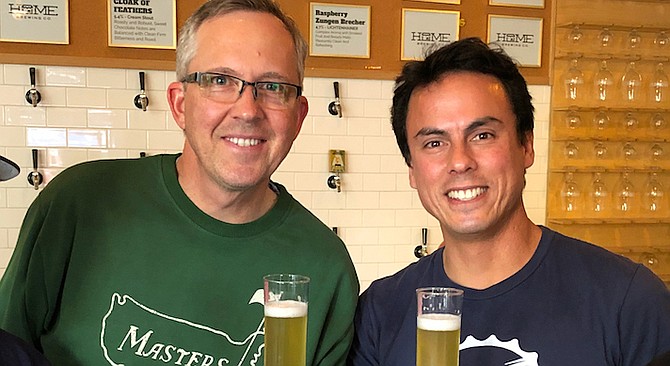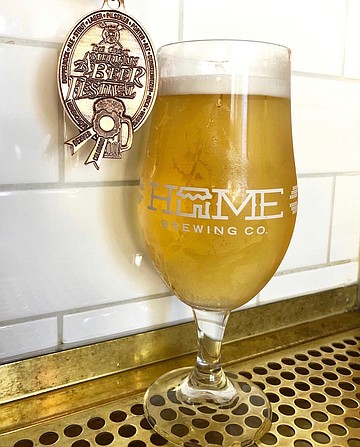 Facebook
Facebook
 X
X
 Instagram
Instagram
 TikTok
TikTok
 Youtube
Youtube

There’s nothing easier to find in North Park than a good IPA. But a good lichtenhainer? Only one place that I know about.
So, what’s a lichtenhainer?
I wondered too. The unsurprising answer would be that it’s a style of beer attributed to Lichtenhain, in the heartland of Germany. More to the point: it’s a smoked sour beer.

There’s a great reason most people have never heard of lichtenhainers: they’re not really made anymore. The style started falling out of favor a century ago, and commercial production ceased by the mid-80s. There’s no category dedicated to lichtenhainers among the hundred styles judged at the Great American Beer Festival.
Nevertheless, North Park’s Home Brewing Co. won a medal in this year’s competition with a lichtenhainer, aptly dubbed Zungen Brecher (the German idiom for tongue-twister). It placed in the Historical Beer category, behind likewise obscure styles: a Norwegian “raw ale” and a Polish smoked beer called a gratzer.

I stumbled upon Zungen Brecher sipping through a flight at the Home Brewing Co. tasting room, while visiting to check out its new cosmetic upgrades and sidewalk drinking patio. The lichtenhainer instantly stood out for its unique mix of lemon tartness and subtle smoke.
Since Home Brewing Co. brews out of homebrew supply shop The Homebrewer, the two-headed business is loaded with people who could explain to me how this virtually extinct German beer came to be brewed and served in North Park.
The story starts with San Diego dentist Scott Rauvola, who began home brewing in 2015. A member of homebrew club QUAFF, Rauvola has won several homebrewing gold medals with rauchbiers, a.k.a. smoked beers, including in national competition. When planning to enter a homebrew contest in summer of 2017, he found a description of the smoked sour in a book of guidelines published by Beer Judge Certification Program.
“It’s always really warm that time of year, and I wanted something refreshing,” Rauvola recalls, “When I read the [lichtenhainer] description I said, damn that sounds good!” But how could he brew a beer style most people have never tasted? Rauvola pieced together through research including historic descriptions and recipes of other hobbyists, shared online, constantly asking himself, “How they would have brewed in 1870?”
“Brewers tend to keep detailed notes,” explains Jacob Bauch, head brewer at Home Brewing Co. “Old beer advertisements were also very descriptive and would often cite the premium ingredients and processes used that put their beverage above the rest.”
Rauvola’s prize for winning Bomberos was to brew his beer commercially with Bauch at Home Brew Co. Working on a small scale, Rauvola had the luxury to treat his water to mimic historic German mineral levels, brew using an old-fashioned decoction method, and monitor the sour’s acidity over ten days of lactobacillus fermentation.
On Home Brew Co.’s seven-barrel brewhouse, a few time-saving adjustments had to be made, but the bulk of the recipe remained intact, including its blend of oak smoked wheat and pilsner malt. Aside from the smoke, Rauvola likens it another tart German beer, a gose.
Bauch admits skepticism at first, figuring they'd make it once and move on. “But then one sip of it and I knew we would brew it on the big scale and enter it in whatever [contest] we could.”
First, they tried the Los Angeles International Beer Competition, but failed to place. However, the judges’ notes revealed it hadn’t been scored, due to lack of familiarity with the style. “We knew we had to get it into the hands of some very professional judges for it to get it's due,” Bauch says, “We were headed to GABF.”
So Bauch and Rauvola brewed it again. Only this time the judges were up to the task, and Zungen Brecher came home with a bronze medal.


There’s nothing easier to find in North Park than a good IPA. But a good lichtenhainer? Only one place that I know about.
So, what’s a lichtenhainer?
I wondered too. The unsurprising answer would be that it’s a style of beer attributed to Lichtenhain, in the heartland of Germany. More to the point: it’s a smoked sour beer.

There’s a great reason most people have never heard of lichtenhainers: they’re not really made anymore. The style started falling out of favor a century ago, and commercial production ceased by the mid-80s. There’s no category dedicated to lichtenhainers among the hundred styles judged at the Great American Beer Festival.
Nevertheless, North Park’s Home Brewing Co. won a medal in this year’s competition with a lichtenhainer, aptly dubbed Zungen Brecher (the German idiom for tongue-twister). It placed in the Historical Beer category, behind likewise obscure styles: a Norwegian “raw ale” and a Polish smoked beer called a gratzer.

I stumbled upon Zungen Brecher sipping through a flight at the Home Brewing Co. tasting room, while visiting to check out its new cosmetic upgrades and sidewalk drinking patio. The lichtenhainer instantly stood out for its unique mix of lemon tartness and subtle smoke.
Since Home Brewing Co. brews out of homebrew supply shop The Homebrewer, the two-headed business is loaded with people who could explain to me how this virtually extinct German beer came to be brewed and served in North Park.
The story starts with San Diego dentist Scott Rauvola, who began home brewing in 2015. A member of homebrew club QUAFF, Rauvola has won several homebrewing gold medals with rauchbiers, a.k.a. smoked beers, including in national competition. When planning to enter a homebrew contest in summer of 2017, he found a description of the smoked sour in a book of guidelines published by Beer Judge Certification Program.
“It’s always really warm that time of year, and I wanted something refreshing,” Rauvola recalls, “When I read the [lichtenhainer] description I said, damn that sounds good!” But how could he brew a beer style most people have never tasted? Rauvola pieced together through research including historic descriptions and recipes of other hobbyists, shared online, constantly asking himself, “How they would have brewed in 1870?”
“Brewers tend to keep detailed notes,” explains Jacob Bauch, head brewer at Home Brewing Co. “Old beer advertisements were also very descriptive and would often cite the premium ingredients and processes used that put their beverage above the rest.”
Rauvola’s prize for winning Bomberos was to brew his beer commercially with Bauch at Home Brew Co. Working on a small scale, Rauvola had the luxury to treat his water to mimic historic German mineral levels, brew using an old-fashioned decoction method, and monitor the sour’s acidity over ten days of lactobacillus fermentation.
On Home Brew Co.’s seven-barrel brewhouse, a few time-saving adjustments had to be made, but the bulk of the recipe remained intact, including its blend of oak smoked wheat and pilsner malt. Aside from the smoke, Rauvola likens it another tart German beer, a gose.
Bauch admits skepticism at first, figuring they'd make it once and move on. “But then one sip of it and I knew we would brew it on the big scale and enter it in whatever [contest] we could.”
First, they tried the Los Angeles International Beer Competition, but failed to place. However, the judges’ notes revealed it hadn’t been scored, due to lack of familiarity with the style. “We knew we had to get it into the hands of some very professional judges for it to get it's due,” Bauch says, “We were headed to GABF.”
So Bauch and Rauvola brewed it again. Only this time the judges were up to the task, and Zungen Brecher came home with a bronze medal.
Comments